2015 VM Benchmarks: Parallels 11 vs. Fusion 8 vs. VirtualBox 5
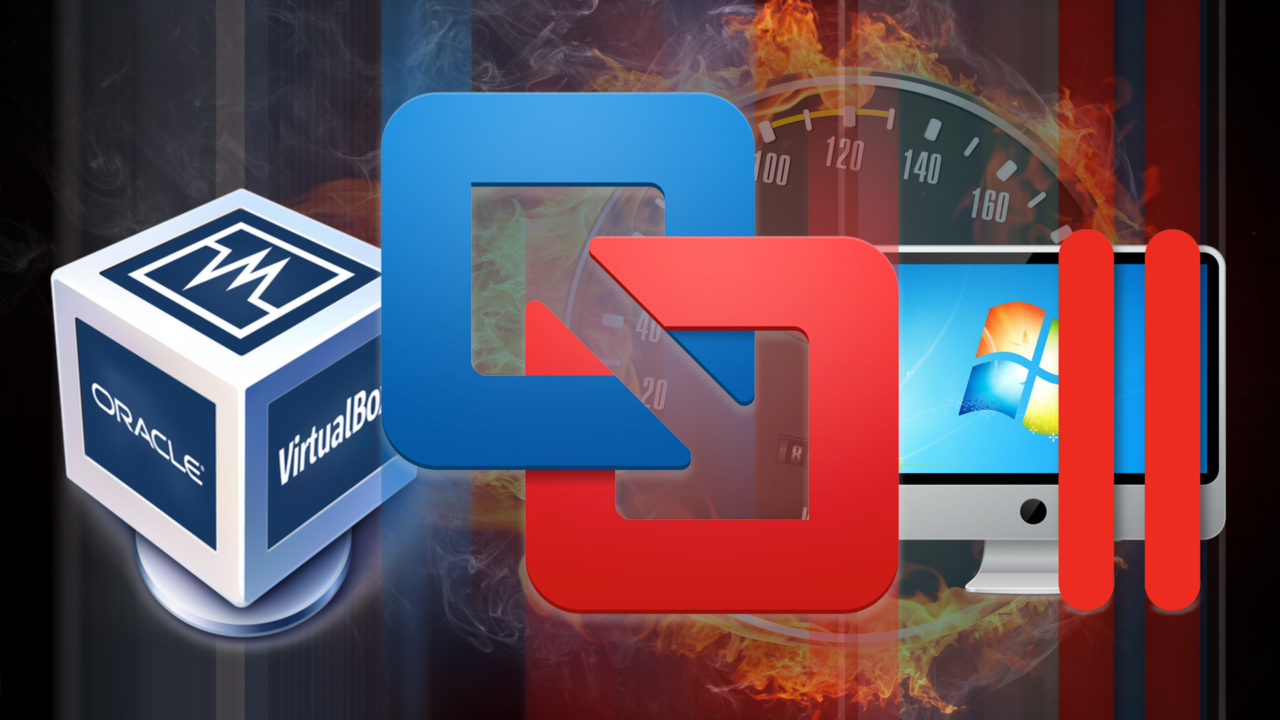
3DMark
Futuremark’s 3DMark is the latest in a long line of industry-standard gaming benchmark suites. 3DMark offers a range of tests that can evaluate the performance of everything from a low-power tablet to a $15,000 quad-SLI gaming PC, and it looks at a CPU’s ability to handle gaming-related physics calculations in addition to pure GPU performance.
3DMark offers multiple tests of increasing complexity that support DirectX 9, DirectX 10, and DirectX 11. However, Fusion 8 and Parallels 11 only support up to DirectX 10, allowing us to run only the entry-level and mid-range 3DMark tests. Of note, VirtualBox technically supports up to DirectX 11, and its graphics driver reports that compatibility to the guest OS, enabling access to the higher-end tests. Graphics performance, however, is so poor in VirtualBox at these higher levels that it is unusable for any practical purpose.
We’ll start with Ice Storm, the lowest-end 3DMark test that uses DirectX 9 APIs.
As we noted in our Fusion 8 benchmarks earlier this week, VMware made graphics performance a major goal of this new release, and that work pays off with Fusion 8 enjoying a significant lead over Parallels 11 in GPU-focused portions of the Ice Storm test. The CPU-bound physics test, however, reveals the much closer competition between these two products, with Parallels narrowly beating Fusion and both approaching near-native performance.
The next test, Ice Storm Extreme, is another DirectX 9 benchmark that runs the same basic script as the standard Ice Storm test above, but increases the resolution to 1080p and utilizes higher quality textures and lighting effects, making it harder overall on the GPU.
When confronted with a more demanding DirectX 9 scenario, Fusion 8 still easily wins, but sees its margin over Parallels 11 fall from about 46 percent to just under 25 percent. Again, we see that Parallels has a slight edge over Fusion when it comes to CPU-focused physics calculations.
The Cloud Gate benchmark is a DirectX 10 test, and the most advanced 3DMark benchmark that’s compatible with our virtualization software.
As expected, neither platform offers anywhere near native performance when it comes to the still-developing DirectX 10 APIs, but Parallels’ implementation of the feature gives it about a 3 percent lead over Fusion 8.
3DMark06
The introduction of DirectX 10 support in Fusion 8 means that we no longer need to rely on older benchmarks in order to have cross-compatibility between the various Parallels and Fusion updates. Since we included it in our individual looks at Fusion 8 and Parallels 11, however, here’s how the two compare in 3DMark06 performance, although this will likely be the last year that this benchmark is included in our testing suite.
The performance margins are much closer in 3DMark06 than they were in the Ice Storm tests, with Fusion performing better in terms of pure graphics power and Parallels taking the lead in CPU-focused tests. Of note, our VirtualBox VM would not complete the 3DMark06 test, and so it is omitted from the results.
Table of Contents
[one_half padding=”0 5px 20px 0″]
1. Introduction
2. Test Setup & Methodology
3. Geekbench
4. 3DMark
5. FurMark OpenGL
6. Cinebench R15
7. PCMark 8
8. Passmark PerformanceTest
[/one_half]
[one_half_last padding=”0 0px 20px 5px”]
9. Video Encoding
10. File Transfers
11. USB 3.0 Speed
12. Virtual Machine Management
13. Battery Life
14. Mac Pro: Gaming
15. Mac Pro: CPU
16. Conclusions
[/one_half_last]





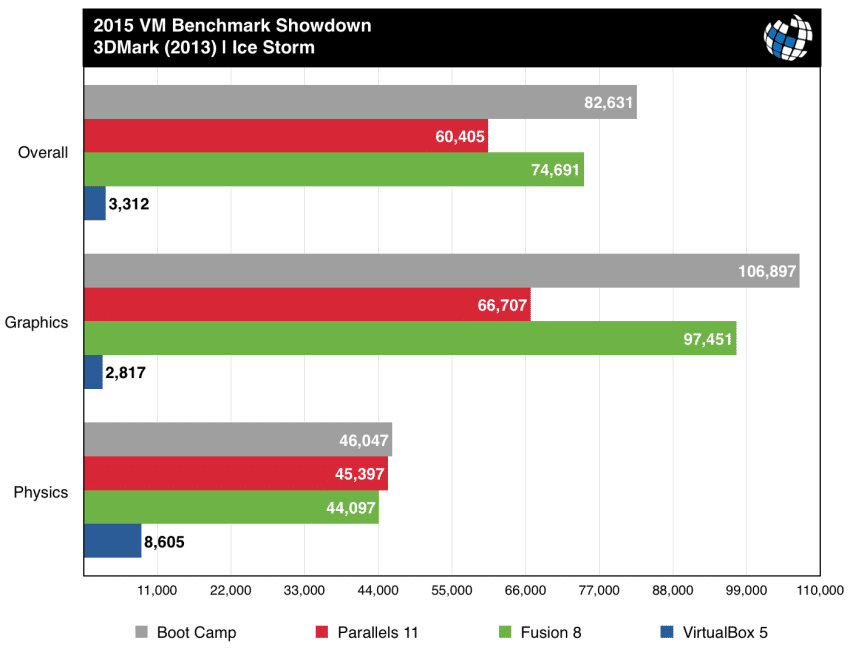
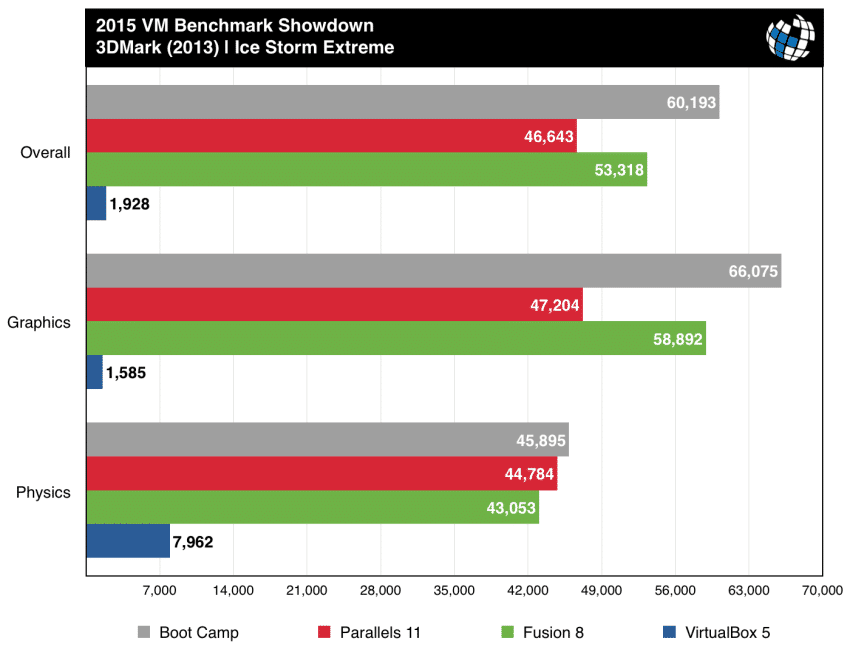
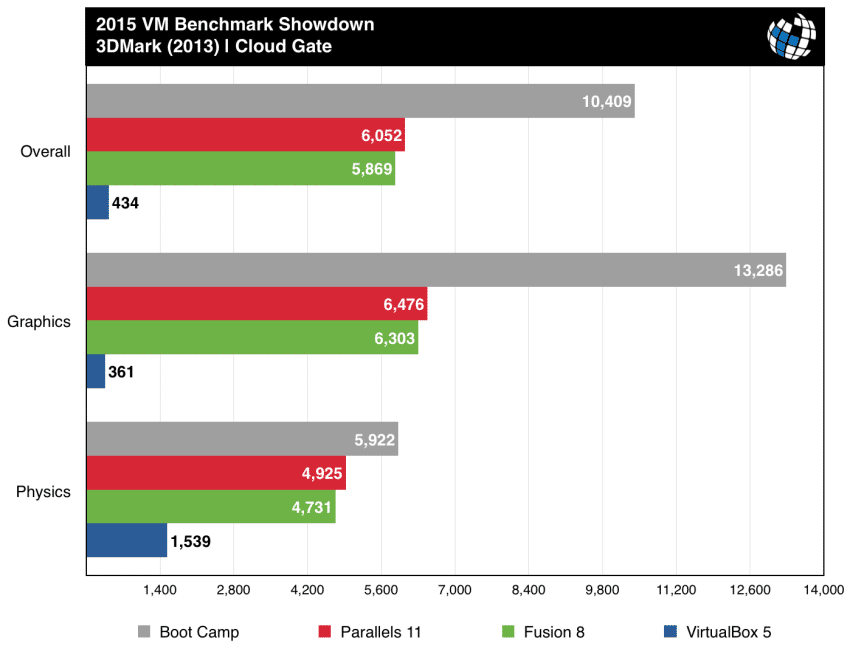
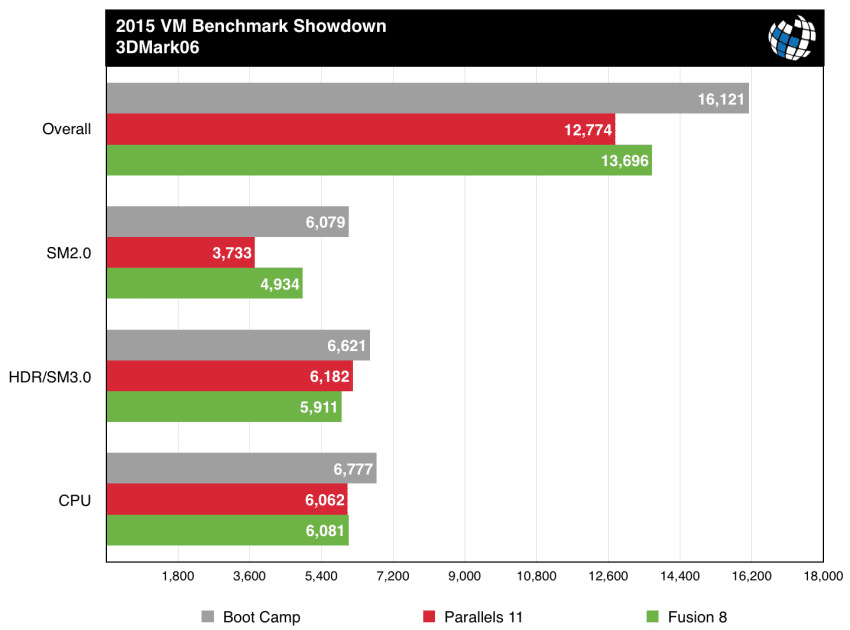













28 thoughts on “2015 VM Benchmarks: Parallels 11 vs. Fusion 8 vs. VirtualBox 5”
* ESXi with macOS guest
Has anyone else notices that Fusion runs a bit “hotter” than Parallels? I find that opening up Fusion to Win 7 or Win 10 automatically gets the temp up at least 20 degrees (F) or so on my rMBP (2015) set for 2 of 4 cores and 8 of 16 gigs of the RAM allocated. This is very disappointing. I have zero issue with the VMware offering (used it years ago) save for this need to use more energy than Parallels. I only use Windows for a couple of apps but I would be worried about adding a more CPU intensive app if heat is generated like this at a greater scale.
Any thoughts or confirmation of Fusion running hotter?
On my current setup it seems to take an eternity for the memory on my Windows VM to be filled with all the data it needs (I need to have a SQL server and a related application running on my Windows OS). Are there any good metrics on how long it takes for the OS to load up files from the drive into memory?
PS: Hard drive is a traditional drive, system report describes as APPLE HDD ST1000DM003
1) The exact models and specifications for the testing hardware are listed in the article, along with the methodology used for the tests. You’ll find this information on the ironically named “Test Setup & Methodology” page.
2) We submitted our results and methodology to both Parallels and VMware to give each company a chance to respond. Neither company claimed that our testing procedure or the configuration of our virtual machines were incorrect or unfair.
3) Other than providing licenses for both Fusion 8 and Parallels Desktop 11 for our tests, TekRevue was not remunerated by either company in any way, nor were the tests conducted or guided by anyone outside of TekRevue.
4) These products, and our review, are primarily targeted at consumers. That’s why we used both a MacBook Pro and mid-level Mac Pro in the tests. If you’d like us to conduct future tests on your custom Mac Pro (I say “custom” because the Mac Pro you describe in your other comment — 2 x 6-core hyperthreaded 3.33GHz — is not a configuration Apple ever shipped), then please send it to us and we’ll be happy to do the additional testing. In general, however, I hope you’ll agree that your specific configuration isn’t applicable to ~99% of users.
I didn’t try any hard-core games, as I don’t use the machine for that purpose. However, multiple version of Windows (XP, 7, 10) ran faster and smoother overall in Parallels for general use in my experience.
Having said that, I had some trouble with Parallels recognizing certain USB devices that Fusion did not have trouble with. Complained about it to Parallels, and they’ve recently pushed out a new release that addressed and fix those problems, so I appreciate their customer support.
Good article, thanks!
VM Capabilities
VM Capabilities
You are forgetting one major thing: Fusion and Parallels are designed to integrate Windows with OS X. VirtualBox is designed to virtualise an entire machine as if it were 100% separate, no integration at all.
It would be worth seeing how Parallels & Fusion (or even Virtualbox, but I assume it’ll look absolutely terrible as far as performance goes) similarly act under a multi-chip host environment to see how they negotiate allocations between multiple physical chips, as opposed to threads all being sent to the same chip.
I’m an enthusiast of fusion 8 and a user fro version 5. This last release is a great goal!
Overall content on Tekrevue is very solid. I enjoy reading OS X tips mostly.
Thanks guys!:)